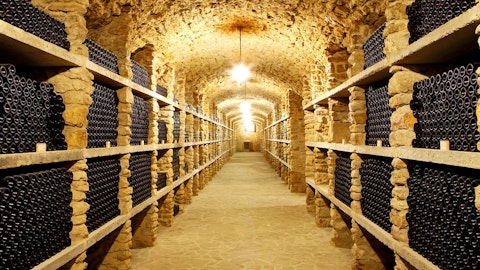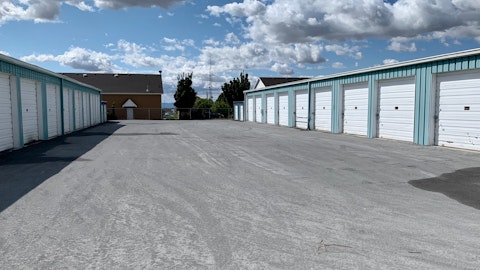Brad Soultz: Yeah. This is Brad. The only thing I would add to that is while non-resi starts are down double-digits, as Tim mentioned, the absolute levels are still extremely robust by any historical metric, right? So we are working against tough comps in 2022, but these absolute levels are still extremely robust and it’s a great platform to build on leading into 2024.
Faiza Alwy: Great. Thank you so much. And I wanted to follow up on capital allocation. So you have devoted more capital to acquisitions and done some of these interesting deals. Should we anticipate more acquisitions of the size sort of what just lay out some of your priorities again as it relates to capital allocation at this point?
Tim Boswell: Yeah. The priorities in the mix have not changed. It’s just very difficult, as you know, to pinpoint the timing and magnitude of any one transaction. Really, the only large — larger transaction that we did was the A&M Cold Storage platform in August or September, right?
Brad Soultz: Yeah.
Tim Boswell: So everything else that we have done has been in that sub-$100 million enterprise value range, which is exactly where we have been transacting over the course of the last three years. And as we think about the 200-plus targets that are in our tuck-in pipeline, that’s the right magnitude to expect. And if we are doing between two and four of those per quarter, that’s pretty much the cadence we have been on for the last three years and I don’t see any real change in mix in terms of the composition of the tuck-in pipeline. In terms of overall capital allocation. I would just refer back to the page 25 in the deck. The target is we think we can deploy about 25% of our capital into those tuck-ins, as I just described.
The organic CapEx will be about another 25%. That will be demand-driven. It will fluctuate period-to-period based on the need to add fleet and add VAPS and refurbishments. And we still see ample surplus capital in a leverage neutral framework, which is why shareholders have seen a 9% reduction in the share count over the last 12 months. And sitting here today, that’s a superb use of our capital and highly accretive long-term and we are going to continue to do it.
Faiza Alwy: Thank you.
Operator: One moment for our next question. And our next question comes from Andy Wittmann of Baird. Your line is open. Again, Andy, your line is open. You may be muted. Okay. Moving forward, One moment. Our next question will be coming from Philip Ng of Jefferies. Philip, your line is open.
Unidentified Analyst: Hey, guys. This is Maggie [ph] on for Phil. Thanks for taking my question.
Brad Soultz: Hi, Maggie.
Unidentified Analyst: I wanted to start out, Brad. I think you mentioned in the prepared remarks, quoting activity for Modular was still up in that kind of 9% range year-over-year, but conversions have been a little softer. Can you talk about what’s driving that? Is that a pricing decision by the customer? Is that just timing and you expect that to flow-through out of greater lag. Can you just talk about what’s going on there?
Brad Soultz: Yeah. Conversions have been just slower and I think it’s primarily driven by labor constraints, backlogs at the general contractors.
Unidentified Analyst: Okay. And then digging in a little more to this cold storage solutions category. Just curious what the strategy is there? How much overlap is there with your existing customer base or end markets and is this a category where there’s going to be chunkier sized M&A deals in this space or still on that kind of tuck-in size range that you see in Modular and Storage?
Tim Boswell: Hi, Maggie. This is Tim. I will start with your second question. And I think the nature of the bolt-ons are actually quite similar to those that we have been executing in the other Modular and Storage categories. So this kind of fits squarely within our strategy. We have the best platform in the — in North America and there are opportunities to build it, both organically and inorganically. It’s a very interesting category in terms of the complementary nature of both commercially and operationally. I will start operationally, because maintaining, delivering, picking up and dropping off this equipment is really no different, requires no different capabilities than we already have in both the Modular and the Storage segment.
So this is very easy for us to execute, just leveraging the existing branch network that we have. I will note that at one point in time, we were actually A&M’s largest customer, because we were renting some of this equipment and then re-renting it to our existing customer base. And you can think about the relevant sectors as being largely outside the construction end market. You can think about any of the retail customers that we have. Any customers in pharmaceutical or in certain manufacturing categories. Certainly, many nodes within the foodservice supply chain and distribution supply chain. We are not just talking about food, things like cosmetics and materials that go into manufacturing processes that need to be kept at a certain temperature.
There are a lot of different applications for those within our current customer base. It’s a category that we have been releasing historically over the years. Although not with the full force of our sales resources behind it. So incredibly excited about how this complements the existing platform, multiple organic and inorganic opportunities. There’s a pricing opportunity. There will definitely be a value-added products opportunity over time and we are really pleased with how the team has come together so far.
Unidentified Analyst: Okay. Great. Super helpful.
Operator: And one moment for our next question. And our next question will come from Manav Patnaik of Barclays. Your line is open.
Ronan Kennedy: Hi. Good morning. This is Ronan Kennedy on for Manav. Thank you for taking my question. Can I ask you guys please for an update on the latest on what you are seeing in terms of demand from megaprojects, the manufacturing trends such as reshoring, renewable investment, the infrastructure program or the fiscal programs as a whole and infrastructure. What you are seeing from that in terms of demand if you are starting to potentially comp over new starts there and then how that was contemplated in your guidance and kind of the assumptions there for volume?
Tim Boswell: Hi, Ronan. This is Tim. I’d say it’s kind of embedded in our outlook for non-residential construction activity, generally speaking. We don’t put a lot of credence into the forecasts that are out there. But if you look at prevailing non-resi square footage forecast for next year, they are flattish and that implies a pretty meaningful mix shift between kind of smaller non-resi projects, think about warehousing and commercial office is obviously being down and we are seeing a mix shift towards the larger, more complex situations that you alluded to. Here we can’t really track every single project and the ultimate funding source, but we can say based on magnitude of opportunities that we see and the prevalence of larger square footage opportunities that, that mix shift is absolutely happening, and from a competitive standpoint, that’s probably our sweet spot in the area where we are best positioned.



